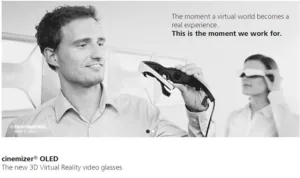Virtual Reality – CNet reports in an article “Virtual reality and the silver screen: A match made in heaven” on virtual reality headsets and their use for showing movies. The article argues that movie apps could be the killer app many virtual headset makers are looking for. The report argues that showing a movie on the headsets may be very immersive indeed.
CNet also sees the use of a headset in situations like a long flight as optimal to use such an application. Samsung has such an application and now Oculus is talking about a similar application for the Rift device.
One of the issues discussed is that virtual reality is perceived in a similar way to 3D – a technology that uses glasses and which never found the wide consumer acceptance that many had expected. One of the issues CNet sees is in the use of the glasses themselves, but it also sees some use factors such as fatigue influencing the acceptance.
The article states that Samsung is worried that the 3D experience may also influence the virtual reality acceptance going forward. Samsung suggests using the virtual headset for shorter periods in the beginning and lengthening the usage over time. Therefore Samsung is thinking of releasing shorter videos at first, followed by full length movies .
The whole idea that movie applications could be the ultimate use for virtual reality is somewhat surprising, as basically all virtual reality headsets started as movie viewers. The article even mentions that Samsung and Sony joined the market after Oculus developed virtual reality headsets. While this is historically incorrect (Oculus developed its virtual reality headset after Sony had released its 3D viewer in the market), the fact that the article makes cinema the killer application without mentioning Vuzix and Zeiss may be hurtful, at least for Zeiss, as you can see in the following image.
Source: Zeiss
Many of the of the earlier models also used OLED displays and banked on movies as the killer application, though this was unsuccessful for them, based on units sold. The technology could never compete with handheld devices like smartphones and tablets that were developed after the first virtual headsets, but have long since reached mass adoption. This shows that the human use factor for headsets is much less favorable compared to handheld devices.
There is always a right time for every technology and it may very well be that the consumer was not ready for virtual reality when it first appeared. With better display technology the time may now be right, though that was what many said about 3D as well. The remaining question is how movies will become the killer application this time, if it didn’t attract the consumer the first time around? – Norbert Hildebrand

